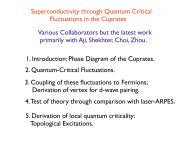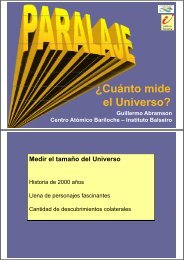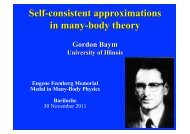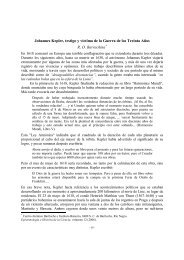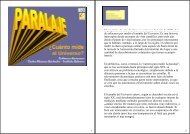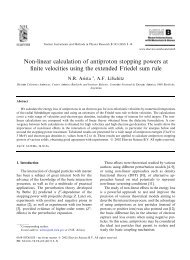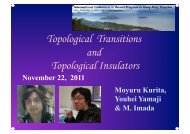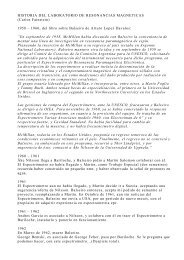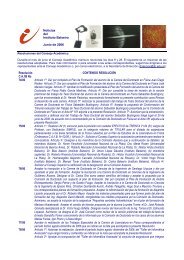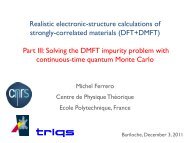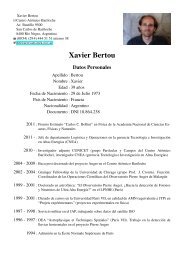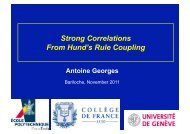Velocity-dependent Potential of a Rigid Body in a Rotating ... - CNEA
Velocity-dependent Potential of a Rigid Body in a Rotating ... - CNEA
Velocity-dependent Potential of a Rigid Body in a Rotating ... - CNEA
You also want an ePaper? Increase the reach of your titles
YUMPU automatically turns print PDFs into web optimized ePapers that Google loves.
4<br />
general be non l<strong>in</strong>ear functions <strong>of</strong> the coord<strong>in</strong>ates. Thus,<br />
<strong>in</strong>clud<strong>in</strong>g the two Lagrange multipliers terms <strong>of</strong> the form<br />
∑<br />
λi f i (q) ˙q i that implement the constra<strong>in</strong>t (9), the Lagrangian<br />
rema<strong>in</strong>s time <strong>in</strong><strong>dependent</strong> and has the form:<br />
energy, the third is an effective centrifugal potential and<br />
the last is an effective potential which depends on the<br />
orientation <strong>of</strong> the body. This last term becomes trivial<br />
only when the body has spherical symmetry.<br />
L = ∑ A i (q) ˙q i + ∑ B ij (q) ˙q i ˙q j − D(q) .<br />
So, accord<strong>in</strong>g to the Noether theorem [22], we have the<br />
follow<strong>in</strong>g first <strong>in</strong>tegral [23],<br />
VII.<br />
CONCLUSIONS<br />
c = ∑ k<br />
˙q k<br />
∂L<br />
∂ ˙q k<br />
− L = ∑ B ij (q) ˙q i ˙q j + D(q) .<br />
This means that we only have to remove the l<strong>in</strong>ear terms<br />
<strong>in</strong> ˙q from the Lagrangian and change the sign <strong>of</strong> the velocity<br />
<strong>in</strong><strong>dependent</strong> term. So, writ<strong>in</strong>g the potential (8)<br />
as<br />
V I<br />
we f<strong>in</strong>ally obta<strong>in</strong><br />
= − 1 2 M (⃗ω × R)2 − 1 ⃗ω · I · ⃗ω<br />
} {{<br />
2<br />
}<br />
velocity <strong>in</strong><strong>dependent</strong><br />
− ⃗ω · I · ⃗Ω − MṘ · (⃗ω × R) .<br />
} {{ }<br />
l<strong>in</strong>ear <strong>in</strong> velocities<br />
c = 1 Ω<br />
2 ⃗ · I · ⃗Ω + 1 2 MṘ2 − 1 2 M (⃗ω × R)2 − 1 ⃗ω · I · ⃗ω .<br />
2<br />
Clearly, this is the non <strong>in</strong>ertial version <strong>of</strong> energy conservation.<br />
The first two terms are the standard k<strong>in</strong>etic<br />
In this article we have discussed the use <strong>of</strong> <strong>in</strong>ertial potentials<br />
<strong>in</strong> the Lagrangian analysis <strong>of</strong> rigid bodies <strong>in</strong> rotat<strong>in</strong>g<br />
frames. Besides describ<strong>in</strong>g the analogy <strong>of</strong> these<br />
potentials with a particular electromagnetic field <strong>of</strong> symmetric<br />
gauge, we presented three examples. They were<br />
chosen as diverse as possible so as to span a variety <strong>of</strong><br />
different situations, <strong>in</strong> order to demonstrate the feasibility<br />
and advantages <strong>of</strong> this description. We conclude that<br />
this is a valid alternative to the standard Lagrangian description<br />
<strong>of</strong> rigid bodies from <strong>in</strong>ertial frames <strong>of</strong> reference.<br />
Acknowledgments<br />
This work was partially supported by the Agencia Nacional<br />
de Promoción Científica y Tecnológica (Grants<br />
03-12567 and 03-20548), Consejo Nacional de Investigaciones<br />
Científicas y Técnicas (Grant PIP 5595) and Universidad<br />
Nacional de Cuyo (Grant 06/C229), Argent<strong>in</strong>a.<br />
[1] M. D. Semon and G. M. Schmieg, “Note on the analogy<br />
between <strong>in</strong>ertial and electromagnetic forces,” Am. J.<br />
Phys. 49, 689–690 (1981).<br />
[2] G. G. Coriolis, “Mémoire sur le pr<strong>in</strong>cipe des forces vives<br />
dans les mouvements relatifs des mach<strong>in</strong>es,” Journal de<br />
l’École Polytechnique 13, 268–302 (1832).<br />
[3] G. G. Coriolis, “Mémoire sur les équations du mouvement<br />
relatif des systèmes de corps.” Journal de l’École<br />
Polytechnique 15, 142–154 (1835).<br />
[4] P. S. Laplace, “Recherches sur plusieurs po<strong>in</strong>ts du systeme<br />
du monde,” Memoires de l’Academie Royale des<br />
Sciences de Paris 88, 75–182 (1776).<br />
[5] J. E. Marsden and T. S. Ratiu, Introduction to Mechanics<br />
and Symmetry (Spr<strong>in</strong>ger Verlag, 2nd. edition, 1999), p.<br />
251.<br />
[6] C. F. Hagenow, “Is There a Centrifugal Force?,” Am.<br />
Phys. Teacher 3, 190 (1935).<br />
[7] G. D. Scott, “Centrifugal Forces and Newton’s Laws <strong>of</strong><br />
Motion,” Am. J. Phys. 25, 325 (1957).<br />
[8] L. D. Landau and E. M. Lifshitz, Mechanics (Pergamon<br />
Press Ltd., Oxford, 1976) 3rd. edition, pp. 126–129.<br />
[9] J. Sivardiere, “On the analogy between <strong>in</strong>ertial and electromagnetic<br />
forces,” Eur. J. Phys. 4, 162–164 (1983).<br />
[10] E. Scher<strong>in</strong>g, “Gött. Abh.”, 18, 3 (1873).<br />
[11] W. Weber, “Annalen d. Phys”, LXXIII, 193 (1848).<br />
[12] E. T. Whittaker, A Treatise on the Analytical Dynamics<br />
<strong>of</strong> Particles and <strong>Rigid</strong> Bodies (Cambridge University<br />
Press, Cambridge, 1904) 1st. edition.<br />
[13] H. Goldste<strong>in</strong>, Classical Mechanics (Addison-Wesley,<br />
Read<strong>in</strong>g, MA, 1981), p. 21.<br />
[14] M. L. C<strong>of</strong>fman, “<strong>Velocity</strong>-Dependent <strong>Potential</strong>s for Particles<br />
Mov<strong>in</strong>g <strong>in</strong> Given Orbits,” Am. J. Phys. 20, 195–199<br />
(1952).<br />
[15] R. Coisson, “On the Vector <strong>Potential</strong> <strong>of</strong> Coriolis Forces,”<br />
Am. J. Phys. 41, 585 (1973).<br />
[16] G. Rousseaux, “The gauge non-<strong>in</strong>variance <strong>of</strong> Classical<br />
Electromagnetism,” Annales de la Fondation Louis de<br />
Broglie 30, 387–396 (2005).<br />
[17] M. B. May, “Elmer A. Sperry and the Gyrocompass,”<br />
The Institute <strong>of</strong> Navigation Newsletter 17 (2), 8–9<br />
(2007).<br />
[18] G. I. Opat, “Coriolis and magnetic forces: The gyrocompass<br />
and magnetic compass as analogs,” Am. J. Phys.<br />
58, 1173–1176 (1990).<br />
[19] J. Barcelos-Neto and M. B. Dias da Silva, “An example<br />
<strong>of</strong> motion <strong>in</strong> a rotat<strong>in</strong>g frame,” Eur. J. Phys. 10, 305–308<br />
(1989).<br />
[20] K. Weltner, “Stable circular orbits <strong>of</strong> freely mov<strong>in</strong>g balls<br />
on rotat<strong>in</strong>g discs,” Am. J. Phys. 47, 984–986 (1979).<br />
[21] A. Bloch, P. Krishnaprasad, J. Marsden and R. Murray,<br />
“Nonholonomic Mechanical Systems with Symetry”,<br />
Technical Report. California Institute <strong>of</strong> Technology.



